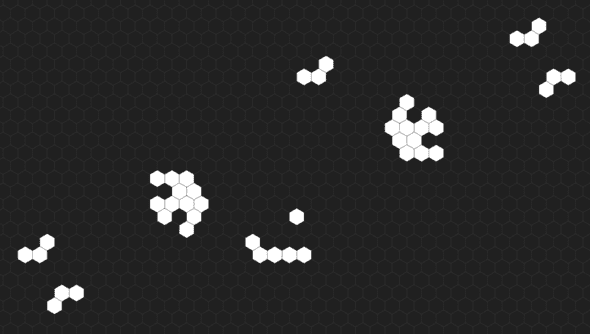gwylim
More Hexagonal Life
December 17, 2016
Following from this post (reddit link), I’ve been looking more into hexagonal cellular automata, and using my simulator have found a rule which supports both orthogonal and diagonal spaceships, with guns and eaters for both (as well as some oscillators and a puffer).
Firstly, I started with these spaceships, which can work in the rules 24/2c and a/2, respectively (using the same convention for naming rules as in my previous post):
I call the left one “diagonal” and the right “orthogonal”, since the right one travels in a direction which is at right angles to the sides of the hexagons.
I modified my simulator to allow advancing a pattern under a particular rule while calculating all other rules which would give the same result for that pattern. Using this, I calculated the set of rules which support both spaceships as 24a(6def)/2c(56bd) (where the parts in parantheses can optionally be included without changing the evolution of these patterns). This gives us a starting point to look at other rules, with the guarantee that those rules will contain at least these spaceships.
Playing around with some of these rules, I found this gun which shoots diagonal spaceships in both directions (supported in rules 24a(e)/256c(d)):
There is also this fast 3-way gun (24(adef)/2c(56de)), which can be generated from just a triangle of three live cells:
I then started investigating the rule 24a/256c, specifically looking for reactions to produce the orthogonal glider, and eaters. It turns out that the simplest possible oscillator can be used to make eaters for both kinds of spaceships, and there is a reaction between diagonal spaceships which produces two orthogonal spaceships. Combining these together, we can create a gun which produces a single stream of orthogonal spaceships:
Note that the eaters are oscillators. Unlike in Conway’s life, still lifes are not possible in this rule, or any of the rules I’ve looked at. Given a random initial configuration, it tends to settle into a state consisting mostly of oscillators. I’ve found four oscillators for 24a/256c:
The leftmost one is the most common by far, and the rightmost is very uncommon.
There is also a puffer which occurs with fairly high frequency:
I spent most of my time looking at 24a/256c, and I haven’t looked systematically at different spaceship-spaceship and spaceship-oscillator collisions, so there is most likely a lot more to discover.





